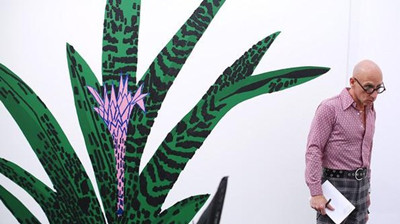藝術市場
Fairly popular
相當流行
The rapid growth of art fairs is changing the way galleries operate
藝術品集會的快速發(fā)展正在改變畫廊的運轉(zhuǎn)方式
That won't fit in the living room
那并不適合放客廳里
SHORTLY after The Economist went to press, about 25,000 people were expected to turn up at the London Art Fair. Your correspondent visited just before, as 128 white booths were being filled with modern paintings and sculptures. Dealers clutched mobile phones to their ears or gathered in small groups. They seemed nervous—as well they might be. “I can earn a year's living in one fair,” said one harried dealer while stringing up a set of lights.
就在本期《經(jīng)濟學人》付印后不久,預計有兩萬五千人次參加倫敦藝術博覽會。筆者之前參觀過這個藝術博覽會,現(xiàn)代畫和現(xiàn)代風格的雕塑填滿了128個白色展覽位。商人們緊緊把手機貼在耳朵旁,或者三五成群。他們看上去神情緊張—也許事實也如此。一位忙碌的經(jīng)銷商一邊忙著吊起組燈,一邊說“一次博覽會能讓我掙足一年的生計”。

Before 1999 London had just one regular contemporary art fair, remembers Will Ramsay, boss of the expanding Affordable Art Fair. This year around 20 will be held in Britain, mostly in the capital. Roughly 90 will take place worldwide. The success of larger events such as Frieze, which started in London, has stimulated the growth of smaller fairs specialising in craft work, ceramics and other things. Art14, which started last year, specialises in less well-known international galleries, showing art from Sub-Saharan Africa, South Korea and Hong Kong.
逐步壯大的平價藝術品展覽會老板拉姆齊,猶記得1999年之前,倫敦只有一個定期開展的當代藝術博覽會。今年,英國將開展20余場,大都聚集在首都倫敦。粗略估計,全世界范圍內(nèi)會開展約90個藝術博覽會。一些大型博覽會,如開辦于倫敦的斐列茲博覽會刺激了小型專業(yè)于藝術品、陶藝品之類博覽會的成長。去年開辦的Art14博覽會專注于一些不知名的畫廊,專門展出一些來自黑非洲、韓國以及香港的藝術品。
One explanation for the boom is the overall growth of the modern-art market. Four-fifths of all art sold at auction worldwide last year was from the 20th or 21st century, according to Artprice, a database. In November an auction in New York of modern and contemporary art made $691m (£422m), easily breaking the previous record. As older art becomes harder to buy—much of it is locked up in museums—demand for recent works is rising.
藝術博覽會的快速發(fā)展原因之一是全球當代藝術品市場的發(fā)展。據(jù)調(diào)研公司Artprice的數(shù)據(jù),去年全球拍賣的藝術品中,有五分之四源于20世紀和21世紀。11月,紐約的一場現(xiàn)當代拍賣會創(chuàng)下了6億9千1百萬美元(約合4億2千2百萬歐元)交易額,輕松打破先前的記錄。由于歷史悠久些的藝術品變得難以購買(大部分都被鎖在了博物館里),所以對于近現(xiàn)代藝術品的需求有所上升。
London's art market in particular has been boosted by an influx of rich immigrants from Russia, China and the Middle East. “When I started 23 years ago I had not a single non-Western foreign buyer,” says Kenny Schachter, an art dealer. “It's a different world now.” And London's new rich buy art differently. They often spend little time in the capital and do not know it well. Traipsing around individual galleries is inconvenient, particularly as galleries have moved out of central London. The mall-like set-up of a fair is much more suitable.
倫敦的藝術品市場還尤其受來自俄羅斯、中國和中東移民浪潮推動。“23年前我剛開始入行的時候,我連一個非西方買主都沒有”一名藝術品經(jīng)銷商沙克特說道:“世道變了”。而且倫敦的新富購買藝術品口味各異。他們很少花時間在成本上,對此了解也不多。漫步在個人畫廊中很不便,尤其是當畫廊都從倫敦市中心搬出去后。而商場式的集會設置就顯得更為合適。
Commercial galleries used to rely on regular visits from rich Britons seeking to furnish their stately homes. Many were family friends. The new art buyers have no such loyalty. People now visit galleries mainly to go to events and to be seen, says Alan Cristea, a gallery owner on Cork street in Mayfair. Fairs, and the parties that spring up around them, are much better places to be spotted.
商業(yè)畫廊過去一向依靠那些英國富人的定期造訪,他們尋求藝術品來裝飾他們富麗堂皇的家。還有一些還是親友。那些新興藝術品購買者沒有這么忠誠。梅菲爾區(qū)科克街的畫廊主克里斯蒂說,人們現(xiàn)在造訪畫廊主要是去參加活動。他們的周圍充斥著各種集市還有聚會,都是更值得去的地方。
Some galleries are feeling squeezed. Bernard Jacobson runs a gallery opposite Mr Cristea. The changing art market reminds him of when his father, a chemist, was eclipsed by Boots, a pharmaceutical chain, in the 1960s. Seven galleries in Cork Street relocated this month to make way for a redevelopment; five more may follow later this year.
一些畫廊感受到了相當?shù)膲毫ΑQ鸥鞑忌?jīng)營的畫廊就在克里斯蒂的對面。藝術品市場的變化提醒他,他的化學家父親因上世紀六十年代的制藥鎖鏈而失敗。本月,科克街的七家畫廊為了再發(fā)展決定遷址;還有五家在今年末也會跟隨他們的腳步遷址。
Yet the rise of the fairs means galleries no longer require prime real estate, thinks Sarah Monk of the London Art Fair. With an international clientele, many can work online or from home. Although some art fairs still require their exhibitors to have a gallery space, increasingly these are small places outside central London or beyond the city altogether. One gallery owner says few rich customers ever visit his shop in south London. He makes all his contacts at the booths he sets up at fairs, which might be twice the size of his store. “It's a little like fishing,” he explains. “You move to where the pike is.”
倫敦藝術博覽會的芒克認為,藝術品集市的興起意味著畫廊再不需要黃金地帶。有了國際顧客,許多畫廊可以網(wǎng)上交易或者居家辦公。即使一些藝術品集市仍然要求參展商擁有展示空間,倫敦市中心外或倫敦之外不斷的有小型地皮出現(xiàn)。一名畫廊主說,他在在南部倫敦的店很少有有錢顧客光顧。他把所有聯(lián)系都放在了他集會的展位上,因為展位可能是他店的兩倍大。“這有一點像釣魚”他解釋道“魚上哪,你上哪。”譯者:周雨晴 校對:曾擎禹












